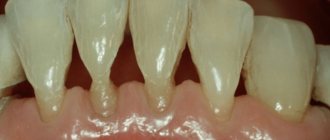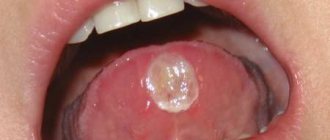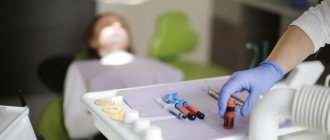Why does a tooth that has no nerve hurt when pressed?
The onset of pain immediately after treatment may be a natural process.
The norm is a period of up to 2 weeks after visiting the dentist. This can be explained by the gums becoming inflamed after manipulation. You should also listen to your own feelings - whether the source of problems is the neighboring tooth, because the source of inflammation in the dentition is very easy to confuse. In this case, you will need treatment again, but without touching the recently placed filling.
The reaction to cold or hot temperature, its rapid changes, is a consequence of the exposure of soft tissues, which, with some stretch, can also be considered the norm in the first days after the procedure.
If the therapy is successful, the pain should gradually decrease until its intensity reaches a minimum. You should only worry when it grows and becomes unbearable over time. Then there is no need to wait 2 weeks, it is better to immediately make an appointment with your dentist. And if the specialist confirms that the painful sensations are localized precisely in the treated organ, then you need to understand why a tooth without a nerve aches and hurts when pressed or pressed and determine what to do in a particular case. Let's present a list of possible reasons:
- Poor hygiene, relapse and re-development of caries. Pathogenic bacteria can actively multiply due to plaque and food debris that accumulate in fissures (the so-called depressions on the chewing surface). Prevention can only be regular cleaning of the oral cavity, visiting the dentist twice a year for professional cleaning, as well as timely healing of even small carious lesions.
- A leaky seal. If the filling is of poor quality, gaps are allowed through which pathogenic bacteria can penetrate. In this case, the decomposition process occurs directly under the filling. This leads to the fact that it is very painful to press on a tooth without a nerve, as inflammation occurs at the root, periodontitis and its support in the bone - the dental-gingival ligament - is destroyed. As a result, rocking begins. Loosening is especially felt when chewing hard food.
- Root damage. If it was hurt during treatment, pain may be felt for a long time.
- Allergic reaction. May occur on painkillers, antiseptics.
- Poor quality materials for fillings, which cause significant shrinkage and the installation begins to move in the cavity, causing pain.
- A big mistake by the dentist: he could have left a microscopic foreign body in the canal, for example, a splinter from an instrument or the dentin itself, fibers from cotton wool.
- Increased fragility of tissues that do not contain pulp. Fragile roots are susceptible to splitting, and the appearance of a crack can become the root cause of painful sensations when chewing.
In what cases is pain in a pulpless tooth dangerous?
DentoSpas Clinic recommends contacting your doctor again if the following symptoms appear:
- the pain becomes sharp, throbbing, intensifies, does not weaken, and may be more pronounced at night;
- painkillers prescribed by the doctor do not work or relieve pain only slightly;
- there is sensitivity, discomfort when contacting cold;
- the patient has a fever and other symptoms of illness: weakness, headache;
- the gums become very swollen and inflamed;
- discomfort persists for a long time or returns some time after treatment (the tooth begins to hurt again).
These signs indicate complications of endodontic treatment. Pain may have several causes.
Reappearance of infection. Occurs if the infected tissue was not completely removed during the initial treatment. A source of infection remained inside the crown, under the filling, and tissue destruction continued.
Errors during filling. If the root canals are not filled tightly or completely, the voids remaining inside them threaten the re-development of infection. Microbes penetrate into them through surrounding tissues, causing inflammation. The pain comes from him. Another possible mistake is that the canals are not filled with filling material to the full depth. To exclude it, the DentoSpas clinic performs control radiography and uses an apex locator to assess the depth of the canals. There should be no voids left at the root apex after filling - this is dangerous due to the formation of granulomas and cysts, and destruction of hard tissues.
The filling material has gone beyond the root tip. This occurs if it is squeezed out through the apical foramen. Dental cement in this case hardens in the periodontal tissues, squeezing the nerves and impairing blood circulation. Because of this, inflammation begins and severe pain appears.
Perforation of the root walls. When cleaning root canals, the root walls may be perforated with an endodontic instrument. At the site of the hole, the tissue becomes infected and inflamed. When filling, perforation is dangerous due to the filling material leaving the root canal.
A fragment of the instrument remains inside the channel. This is a rare mistake. Such debris is clearly visible on control X-ray photographs. If they still remain inside the canal, it becomes clogged, making it more difficult to treat. Because of this, infected tissue remains at the root tip, which provokes re-inflammation.
Complications can arise not only due to treatment errors:
- allergy. Individual sensitivity to the components of the filling material or the medications used, their intolerance can provoke the appearance of pain, swelling, and discomfort immediately after treatment. Such symptoms do not go away on their own, they gradually intensify, and severe inflammation begins;
- damage to the adjacent tooth. The pain in it can spread along the gums and radiate into the pulpless tooth;
- trigeminal nerve injury. It occurs if it passes next to a pulpless tooth and was touched during its treatment. In this case, the pain is shooting, may be accompanied by numbness, and spread throughout the jaw.
Can a filled tooth hurt and react to heat without nerves?
With proper depulpation, the organ should lose any sensitivity, including to temperature changes. Therefore, the occurrence of a reaction to thermal effects probably indicates the incompetence of the doctor, who made a mistake and did not remove all the nerve endings. But sometimes carelessness has nothing to do with it; the cause may be a hidden channel that is not even visible on an x-ray. And another option in which a reaction to hot manifests itself is proximity to a sick neighbor in the dentition.
Treatment options.
After your oral cavity has been examined by your doctor, he will begin dental treatment. And it can be completely different. A cyst, for example, is removed through surgery. This is a small, cheap and safe operation that will relieve you of pain. If the problem is related to various particles getting under the tooth, then only a special device that removes them using ultrasound will help you. This is a completely painless procedure that will take no more than half an hour.
But if you are faced with inflammation of the gums or diseases of the oral cavity, then you need comprehensive, professional treatment. It can last for an indefinite period, depending on the situation itself. Therefore, at the first feeling of discomfort, consult a doctor - it is always easier to get rid of the problem at the initial stage.
What to do if a tooth hurts under a filling, in which there is no nerve, but sensitivity remains
With persistent pain and progressive sensations, the only right decision is to consult a doctor. Only he can remove the pulp completely, even if the nerve endings were left behind, and also determine an additional cause for the symptoms.
Emergency methods of control
If it is not possible to urgently go to the dentist, then it is quite possible to relieve the pain caused by the inflamed nerve residue. To do this, it is enough to drink a strong painkiller or use traditional methods - rinses, lotions. Note that medications need to be dosed, and their compatibility with other drugs must be monitored.
And most importantly, you need to understand that these are only temporary measures that are needed to hold out until the moment when a doctor sees you and provides assistance.
Using medications at home
Even after proper treatment in the dental office, pain is a normal reaction due to irritation of the gums, as well as aching enlarged canals and neighboring teeth. But no one wants to live with constant pain for 7-10 days, so immediately after leaving anesthesia it is recommended to take drugs such as Analgin, Ibuprofen; Ketorol and its analogues are considered the most effective. This will not only remove the symptoms, but also stop the inflammatory process and relieve swelling. You cannot take pills every day. Therefore, if symptoms increase, you should immediately make an appointment with a doctor.
What to do if a pulpless tooth hurts?
First, a diagnosis is made and the causes of pain are found out. To do this, the dentist conducts an examination and takes a control x-ray. If the pain appears due to the re-development of infection, an allergy to the filling material, or due to errors in the primary treatment, retreatment is performed: the root canals are opened, re-processed and filled. If the pain is associated with caries or pulpitis in an adjacent tooth, treat it. In case of injury to the trigeminal nerve, treatment should be comprehensive, with the participation of a neurologist.
You have questions?
We will call you back within 30 seconds
+7
In what cases is the nerve removed from a tooth?
First, let's look at why pulp removal (dental nerve) or depulpation is performed. The need for depulpation arises for several reasons. Practicing dentists identify the following indications for this operation:
- the occurrence of pulpitis: damage to the neurovascular bundle due to the spread of caries,
- extensive deep carious cavity: if the defect is more than 50% of the total volume of the crown, then a filling cannot be placed (it will not hold well and will quickly fall out), and other restoration options - pins, inlays, crowns - involve depulpation,
- the presence of several carious cavities: grinding down the enamel and removing infected dentin can significantly increase the size of the defect, i.e. again, the crown will have to be restored in such a way that pulp removal will have to be carried out,
- mechanical trauma: when a horizontal root crack is detected, for example, periodontitis: inflammation of the tissues of the ligamentous apparatus-1 surrounding the roots.
Other complications
Intense pain is not the only problem that a patient may encounter after pulp removal. The operation can lead to the development of gumboil, as well as loosening of the pulpless tooth.
Flux
Flux is understood as a pathological process in which the periosteum becomes inflamed.
In dentistry, this disease is called periostitis.
Flux develops due to the spread of inflammation from the roots of the tooth, as well as due to damage to soft tissues.
After depulpation, periostitis occurs, as a rule, when antiseptic standards are violated.
This most often occurs when the dentist places a permanent filling immediately after removing the nerve.
Main symptoms:
- Strong pain;
- Tissue swelling;
- Cheek swelling;
- The appearance of a fistula passage;
- Increased body temperature;
- General malaise.
Flux is treated with antibiotics. If conservative therapy does not help, surgical intervention is performed, which involves opening the purulent formation and installing drainage in the gum to remove pus from the periosteum.
Diseases of related organs
If the patient suffers from diseases of the throat, thyroid gland, as well as diseases of the heart, brain or nervous system, all this can affect the health of the dentition. Very often, toothache can occur with a cold, sinusitis or otitis media, but it is not always really pain in the teeth. Sometimes painful sensations in the body flow into the oral cavity and it may simply seem to us that the tooth is sick. To make sure whether it is worth treating teeth or other organs, it is necessary to conduct an x-ray examination.
Hidden caries and gum disease
Caries, especially if it is located between the teeth, is not always clearly visible on the surface of the tooth; sometimes only an experienced dentist in Minsk during a full examination of the oral cavity. Untimely treatment leads to inflammation of the dental nerve and, of course, toothache. In such cases, it is usually necessary to remove the pulp, and sometimes the tooth itself. But in addition to caries, gum disease, such as periodontal disease, can also cause tooth pain. It seems to us that the acute pain is in the tooth itself, but in fact the cause lies in the inflamed gum tissue.
So there is no point in delaying treatment or going to the doctor. And if you are afraid to have your teeth treated, contact the Medexpert Family Dentistry Center. The clinic’s specialists provide treatment, extraction, as well as dental prosthetics and other procedures using sedation. It allows you to increase the pain threshold, relax and fall into medicated sleep. For those who have long dreamed of treating teeth in their sleep , this is the best solution to the problem.
What is a “dead” tooth?
This is what dentists call a tooth without nerve endings that no longer receives blood. Consequently, the tooth stops receiving nutrients and its work stops, the tooth dies. The disruption of blood supply is explained by damage to the pulp, the area where blood vessels and nerve endings gather into a single bundle. If the vessels and nerves do not function, then the nutrients no longer support the life of the tooth.
Temporary pain relief
If you cannot visit a doctor in the near future, and the pain is difficult to endure, you need to turn to painkillers: paracetamol, ibuprofen and others. After their effect ends, you can use antispasmodics, for example, drotaverine. Before taking pharmaceutical drugs, be sure to read the instructions and consult your doctor! Medicines can be supplemented or replaced with traditional methods of pain relief. For example, rinsing with a decoction of herbs (sage, oregano, chamomile) or a soda-salt solution (dilute ⅓ teaspoon of soda and salt in a glass of warm water, rinse your mouth after each meal or attack of pain). Natural propolis also has an analgesic and antiseptic effect if you apply it to the sore area and chew it lightly.
A pulsating tooth is an alarm bell, even if the pain goes away after a while. The problem will not evaporate by itself and will grow like a snowball. We recommend preventing dental problems in advance. To do this, it is enough to visit the dentist only twice a year. The doctor can stop caries in the early stages, prescribe professional hygiene and other strengthening procedures. But if you have a problem with your teeth, don’t try to solve it yourself. You won't treat your own appendicitis, will you? So teeth need a professional approach. Maintain your oral health and maintain a beautiful smile for many years to come.
Treatment at home
Without the help of a specialist, symptomatic therapy can be carried out using pharmaceutical medications and traditional methods of therapy.
Important to remember! Home treatment can only relieve pain when pressed for a short period of time. To completely get rid of a symptom, you need to eliminate the cause of its occurrence.
Medicines
When treating toothache after depulpation, the following drugs are used:
- Ketanov;
- Paracetamol;
- Analgin;
- Ibuprofen;
- Spasmalgon;
- Solpadeine.
The listed painkillers are available in the form of tablets for oral administration.
You need to take medications in accordance with the dosages indicated in the instructions, unless there are contraindications.
For toothache after nerve removal, it is also recommended to use rinses. These include the drugs Stomatofit, Tantum Verde, Chlorhexidine, Angilex.
Traditional methods
To treat toothaches, it is recommended to use the following methods:
- Rinse with Novocaine. To prepare, mix 200 ml of Novocaine solution (1%), 1 spoon of salt, 1 egg white. Rinse your mouth with the resulting mixture for 5-10 minutes. The product relieves pain and relieves the patient from discomfort.
- Wine with herbs. Add 200 ml of wine and 0.5 cups of dried herbs sage and rosemary to the container. The liquid is boiled for 3 minutes, then cooled and a spoonful of honey is added. The finished medicine is used for rinsing 3 times a day after meals.
- Ice compress. Wrap a few ice cubes in a napkin and place them on your cheek in the area of the sore tooth. Due to the effects of cold, pain sensitivity is reduced and swelling is eliminated.
- Chamomile decoction. Add 5 tablespoons of dried chamomile flowers to 1 glass of boiling water. The liquid is boiled in a steam bath for 30 minutes, after which it cools. A warm mouth rinse is used several times a day.
- Salt rinse. To prepare, add 0.5 tablespoons of salt and soda to 1 glass of warm water and mix. You need to repeat rinsing once every 2 hours.
Self-medication can reduce the intensity of pain, but we must not forget about the need to visit a doctor if the pain intensifies or lasts longer than 10 days.











